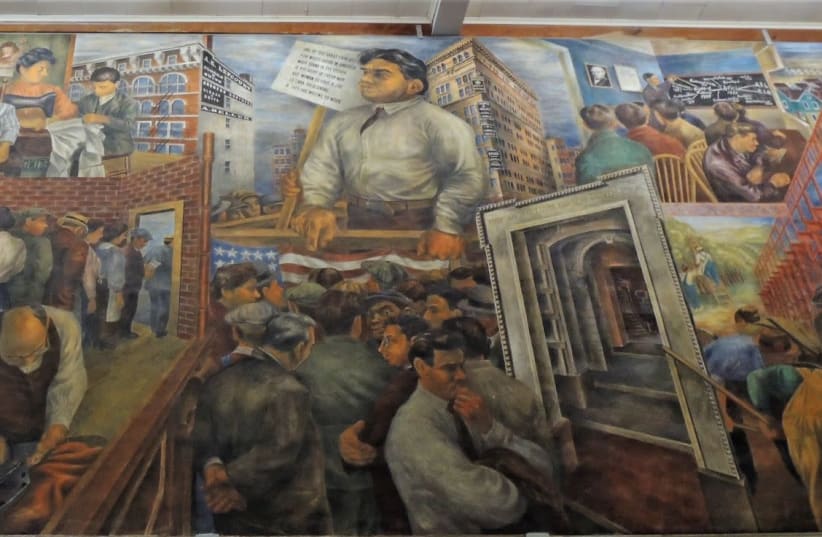John D. Rockefeller, Jr. wanted to create a city within a city: a “mecca for lovers of art.” To that end, he commissioned scores of sculptors, painters and textile workers. He believed in the idea of human progress, which he supported through his philanthropy and how he saw the symbolic value of Rockefeller Center. At the time it stood taller than most of the New York City skyline; nothing stood between it and the Empire State Building, built around the same time.
“New Frontiers’’ was the theme of the Center’s artwork. Rockefeller’s wife, Abby Aldrich Rockefeller, a co-founder of the Museum of Modern Art, a patron of the Mexican artist Diego Rivera, suggested that Rivera be approached to do a mural for the lobby. He was asked to produce “Man at the Crossroads Looking with Hope and High Vision to the Choosing of a New and Better Future.” For the work, Rivera put together a six-person team that included the Social Realist painter Ben Shahn, who had impressed Rivera because of his paintings of Sacco and Vanzetti, two Italian immigrants who were executed on trumped-up charges due to ethnic and political bigotry. Rivera was hired with the knowledge of his leftist political views. After they fled Stalin, Trotsky and his wife Natalia would stay in Mexico City with Rivera and his wife, the artist Frida Kahlo.
Rivera’s original sketch placed a soldier, a worker and a peasant clasping hands at the center, representing unity within the human spirit facing an unknown but hopeful future. What he ended up painting evolved far beyond the original sketch, to become a highly complex mural with social, scientific, ethical, economic and political images, including those representing communism. The latter became too much for the Rockefellers after Rivera added Lenin, and they asked him to remove Lenin. In a letter written by Shahn, Rivera responded: “Rather than mutilate the conception [of the mural], I shall prefer the physical destruction of the conception in its entirety, but preserving, at least, its integrity.”
The drama carried on for months, including public demonstrations, but months later the mural was destroyed.
A FEW years later, Shahn received a commission to create a mural for the community center of Jersey Homesteads, New Jersey. Later renamed Roosevelt, Jersey Homesteads lies just east of Trenton and was established by the Resettlement Administration (RA) as part of Roosevelt’s New Deal (Executive Order 7027). The charge of the RA was to resettle “destitute or low-income families from rural and urban areas” to new communities established on cooperative and collective models.
Jersey Homesteads was conceived as an industrial and agricultural cooperative for unemployed Jewish garment workers from crowded conditions in Manhattan’s Lower East Side. Notes from its early town meetings were written in Yiddish! Houses were built in the simple Bauhaus style on half-acre plots of land surrounded by shared open space. Conservative voices did not approve of the socialist leanings of the RA projects, with one newspaper headline reading “First Communist Town in America Nears Completion.”
Such a nonconformist approach fit very well with Shahn’s attitude toward art. In a lecture at Harvard, he explained “a want of satisfaction with things as they are” propelled artists to “become critics of society, and… partisans in its burning causes,” as witnessed by the “passionate testament of their sympathies as it is written across the canvases and walls of the world.”
Shahn’s mural in Jersey Homelands measures 45 feet (13.7 meters) in length and 12 feet (3.7 meters) in height. It is a fresco, a technique he learned from Rivera, that tells the Jewish immigrant story to the United States. Like Rivera’s mural in Rockefeller Center, it is divided into sections, in this case three sections.
The left panel includes Sacco and Vanzetti lying in their open coffins with a Nazi soldier standing behind the coffins holding a sign (in German): “Germans! Defend Yourselves! Don’t shop from Jews!” Below we find Shahn’s mother, Gittel, and Albert Einstein arriving at Ellis Island.
The middle panel focuses on the issue of worker’s rights. There we see workers in various sweatshops, as well as a union leader painted in the likeness of John Lewis, president of the CIO; and a picket sign with a quote of Lewis visible: “One of the great principles for which labor and America must stand in the future is the right of every man and woman to have a job, to earn their living if they are willing to work.” David Dubinsky, the head of the International Ladies Garment Workers Union is also portrayed.
The far-right panel focuses on a number of individuals important to the New Deal and the Labor movement, surrounding a blueprint of the municipality.
Shahn moved to Jersey Homelands in 1939 with his second wife, photojournalist Bernarda Bryson, whom he met when she came to New York City to do a piece on Rivera’s mural. For decades, Shahn used his artistic skills as social commentary. In that light, his work can be seen like that of the prophets of the Bible whose primary task was to hold a mirror up to society, as a tool to motivate all of us to repair and improve our world.
Shahn’s mural is located in the Roosevelt Public School. Once travel returns to normal post-COVID, prospective visitors can call the school at 609-448-2798 to arrange an appointment to see the mural.
The writer is rabbi emeritus of the Israel Congregation, Manchester Center, Vermont, and a faculty member of the Arava Institute for Environmental Studies and Bennington College.
